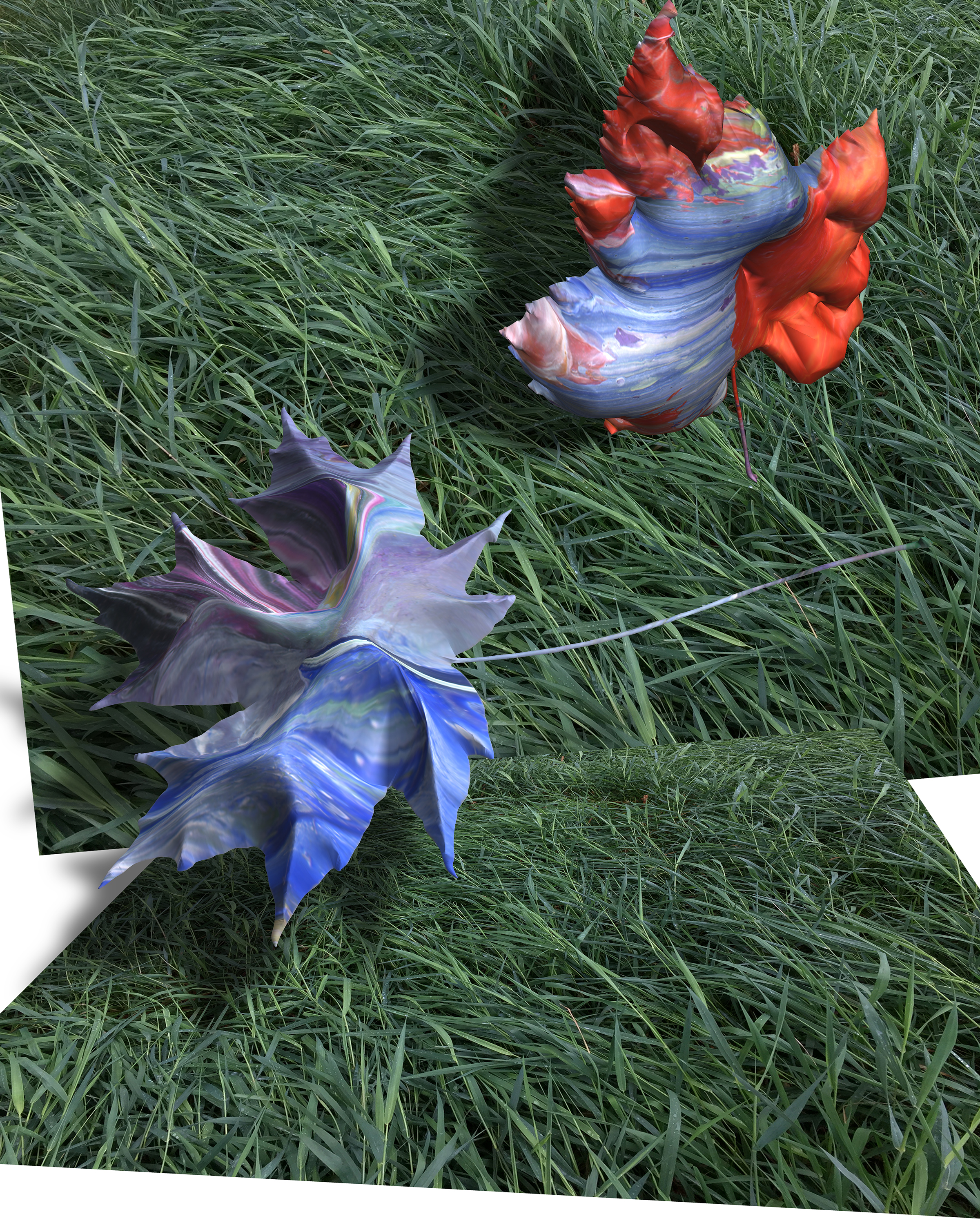The multimedia work of New York artist Bunny Rogers (b. 1990) is “not without its antecedents,” to borrow the words of the architect and former Brooklyn Museum director Philip N. Youtz. Rogers was just 26 years old when the Whitney Museum of Art unveiled her solo show, “Brig Und Ladder,” in 2017. By that point, she had been creating post-Internet installations, animations, and poetry, including hypertext on everything from Neopets to Clone High, for more than a decade. While Youtz was writing about architecture, his observation that even the most “modern and progressive” works stem from an older tradition holds true for Rogers’ works. Her hypertext creations, which lie at the center of Rogers’ artistic practice, harken back to what Rhizome describes as the “1990s tendency toward feminist autobiography in hypertext literature.” Again to borrow from Youtz, one could just as easily say, “The architecture of Bunny Rogers’ hypertext is full of Shelley Jackson’s hypertext memories.”” Though Youtz was discussing the architecture of buildings in the United States and Europe, the same idea of haunting applies: The architecture of Rogers’ hypertext recalls the architecture of Jackson’s hypertext. As a Millennial artist working in hypertext, Rogers reclaims the concept of a quirky curiosity cabinet buried in dust. Thanks to pioneers like Shelley Jackson (b. 1963), hypertext has evolved into a full-fledged museum for feminist stories full of infinite possibilities of body, self, and identity more broadly. These museums are not elitist and overly didactic; they are socially minded and decentralized.
Once upon a time, curiosity cabinets thrived as a type of personal museum full of extraordinary objects. These collections gained popularity among elite European men from the Renaissance through the Victorian era and were meant to illustrate a man’s power and wealth. Note the emphasis on maleness because curiosity cabinets existed as overtly masculine objects. Owning a curiosity cabinet implied that you could travel far and wide, which most “proper” women did not do then (disregarding the fact that men owned property; women did not.) A curiosity cabinet symbolized what one could conquer and colonize abroad. It represented a social dynamic of winners and losers, hunters and prey, collectors and collectibles. Jackson writes about ownership as a gendered action in her hypertext Patchwork Girl: “I belong nowhere.’ This is not bizarre for my sex however, nor is it uncomfortable for us, to whom belonging has generally meant, belonging TO.” Each new acquisition to a curiosity cabinet was functionally a trophy—an icon of victory. Once a new acquisition was put in place, the quest began anew. The victor had to keep collecting in order to maintain his social position. These collections did not necessarily indicate learning or insight; they pointed to power. Curiosity cabinets lacked trained curators and therefore, according to criticism of the time and shortly thereafter, curatorial focus and rigor, including context and cataloguing.
Jackson reclaimed the notion of a curiosity cabinet as a masculine phenomenon with her hypertext My Body—a Wunderkammer. (Wunderkammer is the German word for curiosity cabinet.) At its current eliterature.org home, the work bears the description of “a semi-autobiographical hypertext combining text and image in an exploration of the body.” Jackson subverts gender roles and takes ownership of her curiosity cabinet—something she probably could not have possessed a century or two ago. As the owner, she occupies the cabinet with the relics of a proudly feminine body. The hypertext’s narrator possesses an awareness of her physical self as a projection of her mental and spiritual self. Likewise, the men who historically owned curiosity cabinets knew that their collections communicated who they were, or how at least how they wanted to be perceived. The narrator’s ownership of her body in Jackson’s Patchwork Girl and My Body echoes how Rogers positions avatars as extensions of her female body on the Internet. As Vice put it in a 2017 review of Rogers’ Whitney show, these avatars inspire viewers to “sub in their own avatars and meditate on loss, mourning, and ultimately connection.” That call for connection and empathy is not a competitive, conquering act but an inclusive one coming from a femme perspective. Again, a subversion of what a curiosity cabinet was and what a museum can be.
Unfortunately, subversive acts are not always widely recognized. Shelley Jackson is still better known as a fiction writer than a hypertext writer specifically—despite the level of innovation behind Patchwork Girl and My Body. Some critics perceived early hypertexts as frivolous novelties, much as critics came to view curiosity cabinets. In the acknowledgments for his scholarly book Hypertext, George P. Landow thanks editor in chief Eric Halpern at Johns Hopkins University Press for championing his manuscript when editors at other academic publishers found the project “too strange or too unintelligible.” Curiosity cabinets, like Jackson’s semi-autobiographical hypertexts, were considered too idiosyncratic, too deeply personal by some. Unsurprisingly, Rogers’ work has been categorized as esoteric and melodramatic. In his Art of America write-up of Rogers’ work at Greenspon Gallery in 2016, critic Brian Droitcour described an Columbine Cafeteria installation—which includes her video Poetry reading in Columbine Cafeteria with Gazlene Membrane & Poetry reading in Columbine Library with Joan of Arc—using words often associated with curiosity cabinets: “quirky” and “sentimental.” An Art Book Review piece was more blunt in its description of Rogers’ sculptural book, Cunny Poem, Vol. 1.: “Everything is high theatrics and crushing autobiography at once.” Yet why is it that women’s stories are “personal” or “quirky” or “sentimental” when (white heterosexual) men’s stories are simply stories? In contrast, the formal museums that came after curiosity cabinets were not supposed to reflect personal tastes but rather learning as defined by the powerful men who ran them. Museums told the stories these men wanted them to tell through how artifacts were presented in exhibitions. Masculine power dynamics remained the norm, even if collections became less individualized.
Once early museums supposedly evolved past the status of collections of “chance assemblage,” Joel J. Oroz, author of Curators and Culture: The Museum Movement in America, 1740-1870, points out that some saw beyond museums’ scholarly potential. Oroz singles out a young graduate student from the period—Theodore L. Low—who wrote that museums were, or at least ought to be, “social instruments.” Orosz asserts that Low was not alone in his thinking and that “[early museum] proprietors displayed serious motives and egalitarian aspirations.” Similarly, Jackson saw her hypertext work as socially aware creative work centered on the female body; Rogers focuses on female and other marginalized bodies through Internet avatars. Hypertext is not a scholarly endeavor, but it was no “sideshow,” either. Early hypertext had a serious goal: to respond “to the strengths and weaknesses of the printed book.” One weakness? Its hetereopatriarchal origins—so common to technology—which Shelley bucked and Rogers continues to buck. Jackson and Rogers are both women creating semi-autobiographical hypertexts that tell stories from a woman’s perspective. That viewpoint is an obvious detraction from traditional books, which trend toward male narrators and protagonists. The viewpoint runs parallel with advances in museums, whose staffs and voices are becoming increasingly diverse, though far from perfect. But the viewpoint is not where the feminist slant of Jackson’s and Rogers’ works ends.
The architecture of Rogers’ and Jackson’s hypertext is perhaps its most feminist feature. As decentralized works, they offer the reader multiple possibilities for approaches to readership. There is no unary (male) or binary (male-female) reading experience. Rather, there exists a whole spectrum of experiences. Landow cites Jacques Derrida, Theodor Nelson, Roland Barthes, and Adries van Dam to explain that hypertext is not about “ideas of center, margin, hierarchy, and linearity” but rather ideas about “multilinearity, nodes, links, and networks.” This “means that anyone who uses hypertext makes his or her own interests the de facto organizing principle (or center) for the investigation at the moment.” Similarly, modern museums are becoming less and less didactic and more experiential sites for “multisensory immersion.” Today’s museums ask questions and issue provocations. They are interactive and thus expect a participation from us, the visitors. Similarly, you cannot experience a Bunny Rogers hypertext simply by observing it. You must click in order to gather any speck of a story, whether you are visiting Sister Unn’s floral shop or Rogers’ bedroom full of ribbons.
Likening the hypertext and multimedia work of Jackson and Rogers to curiosity cabinets and museums should not be done without mentioning the issue of preservation. While Jackson’s work has no place in traditional museums from a generation ago, Rogers’ work is finding a space in modern museums. Feminist hypertext and its affiliates were never meant to be elitist; they were meant to be democratic. Though technological obsolescence has made Jackson’s hypertext work harder to experience, the pieces were made using popularly available resources for their time. Rogers’ works are easier to access and may remain easy to access in the future, especially as museums continue to uphold her feminist autobiography as fine art.
Works Cited
Brenston, Margaret. “Worlds Apart: Women, Men, and Technology.” Center for Media Literacy. http://www.medialit.org/reading-room/worlds-apart-women-men-and-technology.
Bunny Rogers portfolio site. Meryn.ru. http://meryn.ru/
Droitcour, Brian. “Bunny Rogers.” Art in America. https://www.artinamericamagazine.com/exhibitions/bunny-rogers/. Published June 2016. Accessed October 2018.
Jackson, Shelley. My Body—A Wunderkammer. Electronic Literature Collection. http://collection.eliterature.org/1/works/jackson__my_body_a_wunderkammer.html. Published 1997. Accessed October 2018.
Jackson, Shelley. Patchwork Girl. Wastertown, Mass.: Eastgate Systems, 1995.
Landow, George P. Hypertext: The Convergence of Contemporary Critical Theory and Technology. Baltimore and London: The Johns Hopkins University Press, 1992. (Acknowledgements, Pg. 2).
Orosz, Joel J. Curators and Culture: The Museum Movement in America, 1740-1870. Tuscaloosa and London: The University of Alabama Press, 1990. (pgs. IX, 1-5).
“On the front page: Shelley Jackson’s hypertext autobiography.” Rhizome. https://rhizome.org/editorial/2015/nov/23/my-body-a-wunderkammer/. Published 2015 November. Accessed 2018 October.
Sokol, Zach. “Bunny Rogers on her Deeply Intimate Solo Show the Whitney.” Vice. https://i-d.vice.com/en_us/article/9kkjb3/artist-bunny-rogers-wants-you-to-know-she-acknowledges-your-hurt.
Youtz, Philip N. Reading with a Purpose: American Life in Architecture. Chicago. American Library Association, 1932. (pgs. 9-10).
:::

Christine Sloan Stoddard is a Salvadoran-American writer and interdisciplinary artist. She is the founder of Quail Bell Magazine and the author of Belladonna Magic (Shanti Arts), Water for the Cactus Woman (Spuyten Duyvil), Hispanic and Latino Heritage in Virginia (The History Press), and other books. She recently completed her term as the first-ever artist-in-residence at Lenox Hill Neighborhood House, a 124-year-old settlement house in New York City. Learn more about Christine and her work at WorldOfChristineStoddard.com.



